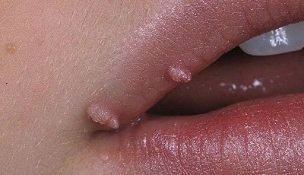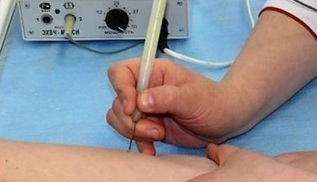When nipple-like growths appear on the torso, limbs or face, it is always an unpleasant surprise for a person. These are benign formations on the skin, which can be multiple or unique. Papillomas in the body, unfortunately, are a very common disease that develops due to infection with human papillomavirus (HPV), but their treatment in modern conditions is not a problem.
What are papillomas in the body
Papillomavirus is a benign tumor that grows from the tissues of the squamous epithelium. It appears as a drop or papilla on the skin, mucous membranes and can affect a person's internal organs. There are more than 30 types and subspecies of HPV that can easily enter the human body. Depending on the type of pathogen, different groups of papillomas are formed in the body. They differ in growth rate, appearance, location.
Papillomavirus can be detected anywhere in the body:
- natural folds: groin, armpits, mammary glands, lower abdomen;
- face: eyelids, close to the eyes, close to the mouth;
- torso: back, abdomen, neck, hands, feet;
- genitals: vagina, penile area;
- internal organs: intestines, stomach, bladder, esophagus, larynx, trachea.
What does a papilloma look like

HPV can look different on the outside. As a rule, they are oval protuberances on the body or rounded processes on the skin that resemble a papilla.
They can be small (1-5 mm), medium (1 cm), large (1-3 cm) and giant (more than 3 cm) in size. The texture of the papules is relatively loose and soft. Blood vessel intercalations are often visible on the surface.
The color is mainly pulp and all varieties of brown. There are cases in which the papillomas have shades of blue, violet and even black and charcoal.
Why papillomas appear
These growths in the body are viral in nature. The infection is transmitted by contact with a carrier of a healthy person. Men and women are equally susceptible to infection, but are affected differently by the virus. The weaker sex may experience burning and itching in the genital area, bleeding and other strange secretions from the vagina. Sometimes, the disease is accompanied by syphilis, chlamydia, herpes and other sexually transmitted diseases.
Men are not afraid of certain types of the virus that are dangerous for women (16, 18). However, strong sex carries infections. Papilloma of Organs genitals, frenulum and glans of the penis or urethra, are benign painless neoplasms of types 6 and 11 that must be removed. Penile cancer is very rare.
Infection methods
The infection is especially active in gyms, swimming pools, saunas, baths. Other reasons for the appearance of papillomas in the body are sexual intercourse, childbirth (from mother to child).
Here are some more ways to get infected with the human papillomavirus:
- when kissing, because the virus is contained in saliva;
- when using infected personal items;
- in case of insufficient processing of medical instruments.
Types and types
The number of types of neoplasms in the body is estimated in dozens, so doctors divided them into 5 groups, combining them by color, symptoms and risk of malignant skin cell degeneration:

- Simple papillomas.They are also called common warts. It has the broadest prevalence. The first sign of HPV is a small tumor on the skin. In the process of development, it turns into a dark keratinized tuber. It is located in groups and individually. Favorite locations are the hands, the lower part of the face.
- Flat papillomas.One characteristic is an accumulation of growth groups. The flat papillomas do not have a bulge, but are painted a dark color. The main place of distribution is the upper body, the genital area.
- Genital warts.The location is the mucous membranes of the body and genitals. These strains are at risk of cancer. The main cause of genital warts is sexual intercourse.
- Filiform papillomas.In the scientific world, they were called "acrocords". A characteristic of this species is the leg that supports the mole. Acrocords are senile growths, since they appear mainly in the body of middle-aged and elderly people.
- Internal papillomas.This subgroup includes all neoplasms that develop in Organs internal organs. It is impossible to independently recognize genital warts in this group, which requires a special diagnosis. The presence of a disease can cause symptoms.
Danger of viruses
Human papillomavirus infection is generally not a major health risk. However, some species are capable of degenerating into a malignant tumor. Non-oncogenic papillomas can also create many disorders if they start to grow, for example, on the back, mouth or groin area. They are often injured, after which ulcers and sores remain in the body, open to infections. Bladder condylomata often cause an inflammatory process and growths in the uterine cavity sometimes lead to female infertility.
Diagnosis
If you notice a papilloma in your body, you should see a dermatologist. After the initial examination, the doctor will refer the patient for cytological examination and blood test (tumor markers, HPV, DNA). This is necessary to determine the pathological processes and to determine the type of viral infection in relation to the oncogenic risk. If a tumor appears on the cervix, a colposcopy will be required.
How to get rid of papillomas on the body
There are many methods of treating growths. It is best to stop the growth of papillomas in the body during complex therapy. It is impossible to completely expel the human papillomavirus from the body, but it is possible to reduce its activity for a long time by increasing immunity. The proliferation of papules is treated with surgical and therapeutic methods. Popular recipes also help during HPV infection.
How to get rid of HPV with medications
When HPV first appears, doctors prescribe medication to reduce the chances of infecting others. Various medications are used to fight viral infections in gynecology and dermatology.
Laser removal
People often resort to surgical removal of tumors if they appear unsightly or cause discomfort, for example, if they are in intimate places, on the neck or natural skin folds. The removal of laser papillomas takes several minutes. Its essence is in the use of a device that eliminates a neoplasm. There is no contact with the skin, which ensures high safety of the procedure. The advantages of the technique include the absence of blood loss, painlessness and rapid recovery.
Cons of laser treatment:
- high cost;
- inability to study remote growth.
Liquid nitrogen
The removal of neoplasms with liquid nitrogen (freezing) is no less effective. Although the procedure is simple, it requires preparation: wash the areas of the skin that will be frozen well, shave the hair, if any. To apply nitrogen, the specialist uses a metal cotton swab with a cotton tip, which is dipped in a container with a transparent liquid. After that, contact with the papilloma occurs in 1-5 seconds. Recovery takes place within 2-3 days. The advantages of the procedure are simplicity and speed of the procedure, high efficiency.
Disadvantages of the method:
- the likelihood of damage to surrounding tissues;
- pain while driving;
- fails to remove large growths,
Treatment of papillomas by radio wave method
The essence of the technique is to influence the accumulation of high frequency radio waves, which are completely harmless to health. To remove the papilloma, the doctor fixes the bundle for several seconds at the point of the problem. After the procedure, drug therapy is prescribed. The advantage of the radio wave method lies in its versatility - different types of warts, blemishes, papillomas on any part of the skin disappear easily. It can be used even in difficult areas, such as the eye area. There are no scars after the procedure.
Disadvantages of the method:
- high cost;
- is not effective for removing large growths.
Electrocoagulation

A medical procedure in which benign growths are removed with a precisely coordinated electrical current. Electrocoagulation is performed with a device equipped with a handle and an electrode, which are heated to high temperatures. The manipulation is done under local anesthesia. For children, removal is performed under general anesthesia. After burning the tumor, the skin is treated with an antiseptic. The procedure takes 5 to 10 minutes.
The advantages of the method include safety and efficacy in removing a skin disease, avoiding the likelihood of infection and the possibility of histology.
Disadvantages of electrocautery:
- risk of residual scarring;
- relative pain;
- long recovery period (up to 10 days);
- at the removal site, relapses are possible.
How to remove spots and papillomas with folk remedies
According to the evaluations of patients with HPV, the use of alternative prescriptions after drug therapy and / or any removal methods helps to remove the virus more quickly.
At home, when external manifestations of papillomas occur, the following methods are effective:
- Celandine.It is necessary to lubricate the skin with neoplasms with fresh plant sap several times a day.
- Banana.To speed up therapy, it is necessary to apply the fruit pulp to neoplasms. The banana is especially effective for small plantar warts.
Prevention
The following preventive measures are shown to prevent relapse:
- to have periodic HPV tests;
- avoid casual sexual contact;
- maintain immunity: eat well, season;
- control growth and changes in the form of untreated papillomas;
- vaccinate with 2% serum (three times in six months).














































































